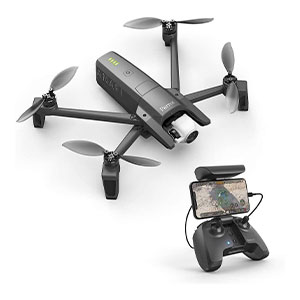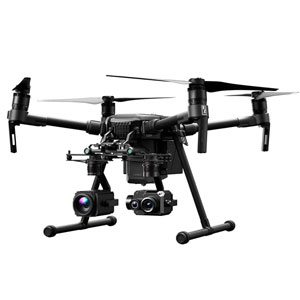As an affiliate, we may earn a commission from qualifying purchases. We get commissions for purchases made through links on this website from Amazon and other third parties.
Power line inspections are often associated with significant expenses and time consumption. However, the utilization of drones can substantially reduce costs. spans several days. Conversely, drones can perform equivalent tasks at a fraction of the expense within minutes.
The advantages of drone inspections extend beyond cost-effectiveness. They enhance safety and precision compared to conventional evaluation techniques. By enabling workers to analyze drone-derived inspection data from a secure distance, drones eliminate potential hazards. Advanced cameras and sensors on drones facilitate the creation of 3D maps for power line corridors, enabling the swift identification of irregularities, defects, and encroaching vegetation with remarkable accuracy.
No products found.
For proprietors of these assets, drones offer an appealing solution for frequent and high-quality inspections. Nevertheless, they also introduce novel challenges. Navigating around high-voltage electrical wires requires expertise. The selection of an appropriate pilot and drone is crucial.
Drones lacking adequate navigation and obstacle avoidance technology are at a higher risk of collisions. A single mishap can result in the destruction of the drone and costly damages to the power infrastructure. Employing an inexperienced pilot further compounds risks, potentially leading to subpar or inadequate inspection data, entailing long-term expenses.
Best Drones for Power Line Inspections Reviews
1. DJI Matrice 300 RTK
The Matrice 300 RTK stands out as an exceptional drone choice for conducting power line inspections. Among its distinctive attributes is its advanced dual control system, enabling a secondary pilot to assume control during flight. This feature proves particularly valuable for extensive inspection undertakings, distributing operational responsibility between two pilots instead of relying solely on one.
True to its name, the Matrice 300 RTK is equipped with cutting-edge real-time kinetic (RTK) positioning capability. Leveraging live GPS data, RTK ensures precise drone positioning mid-flight. This capability proves invaluable during power line inspections, where maintaining accurate flight paths is essential to avert costly collisions.
Moreover, RTK positioning instills confidence in automated routine inspections, minimizing the risk of human piloting errors. Complementing this, the drone’s 6-directional sensors empower it to autonomously navigate around obstacles while maneuvering through hazardous power line environments.
While the Matrice 300 RTK itself does not include a payload, it boasts compatibility with DJI’s Zenmuse series and third-party payloads. For optimal results, coupling the Matrice 300 RTK with the Zenmuse Z30, featuring a 30x optical zoom, or the Zenmuse H20T, encompassing a laser rangefinder (LRF), visual zoom camera, and thermal camera, is recommended. Moreover, third-party payloads can further extend its capabilities, making it adaptable to various scenarios.
The drone boasts an impressive 55-minute flight time, albeit under payload-free conditions. When equipped with the Zenmuse H20T, the flight time is approximately 40 minutes, while a lighter payload like the XT2 grants around 46 minutes of flight time. Notably, flight duration varies based on the payload type, mission objectives, and prevailing weather conditions.
2. DJI Mavic 2 Enterprise Advanced
The Mavic 2 Advanced stands as a high-performance drone tailored for dual imaging capabilities. Although the option to interchange payloads is not available, it is equipped with an integrated thermal sensor and a 4K zoom camera. On one hand, the infrared sensor boasts a remarkable 16x zoom, 640 x 512 resolution, and a rapid 30 Hz frame rate.
It exhibits precise temperature measurement within a 2°C accuracy range. Conversely, the 4K visual camera excels with its 48 MP resolution, 4x lossless zoom, and impressive 32x digital zoom, ideal for capturing intricate details.
An important feature of the Mavic 2 Advanced is its OcuSync 2.0 transmission system, offering robust protection against electromagnetic interference arising from power lines. With a transmission range extending up to 6.2 miles (10 km), it facilitates seamless transitions between visual, thermal, and split views on a single screen, streamlining the inspection process.
Comparable to select drones in our compilation, the Mavic 2 Advanced integrates omnidirectional obstacle sensing and DJI AirSense, providing real-time updates on airspace conditions. Moreover, the option for RTK positioning, ensuring centimeter-level precision, can be added separately.
Boasting a compact yet durable design, the drone is conveniently foldable for easy portability and can operate within temperature ranges of 14°F to 104°F (-10°C to 40°C). As an added benefit, the Mavic 2 Advanced offers password protection, granting you peace of mind by restricting unauthorized drone operation.
In conclusion, the Mavic 2 Advanced serves as an excellent choice for individuals seeking simultaneous visual and thermal inspections without the need for manual payload configuration.
3. Autel Robotics EVO II
The Evo 2 Dual 640T RTK represents a highly capable compact drone featuring integrated visible and infrared cameras. The 8K visible camera boasts a remarkable 4x lossless zoom capability and records 6K video at a maximum streaming speed of 120 Mbps. Video transmission can extend up to an impressive 5.6 miles (9 km), with a maximum service altitude of 3.7 miles (6000 m).
The infrared sensor offers superior thermal imaging resolution, enabling precise temperature measurement within a range of 6.5 to 16.4 feet (2 to 5 m) from the heat source, with an accuracy range of 3°.
True to its nomenclature, the Evo 2 Dual 640T RTK introduces RTK positioning technology. Furthermore, it features post-processed kinematic (PPK) positioning, enhancing accuracy further. Similar to RTK, PPK leverages GPS technology to rectify location data, but it does so after data collection and uploading into mapping software.
Boasting an impressive 36-minute flight duration and a top speed of 65 feet per second (20 m/s), the Evo 2 Dual 640T RTK efficiently executes extensive power line inspections. Operating within temperature ranges of 14°F to 104°F (-10°C to 40°C), the drone’s versatility is evident. Additionally, its 6-directional sensing system ensures comprehensive 720° obstacle avoidance.
For those seeking a swift and dependable solution for initiating power line inspections, the Evo 2 Dual 640T RTK emerges as a superior choice, particularly due to its foldable design and reliability.
4. Parrot PF728000 ANAFI
The Anafi drone, developed by the French company Parrot, is a rising star in the drone industry. Despite its incredibly light weight of merely 1.98 pounds (898 grams), it boasts a remarkable array of features. What truly sets this drone apart is its groundbreaking use of the Verizon 4G LTE cellular network for communication, enabling it to take flight in areas with cellular coverage. Furthermore, the drone offers the unique ability to seamlessly switch between 4G and WiFi connections, granting it an almost boundless operational range.
Naturally, the flight duration is still subject to the drone’s battery life, but even at a maximum of 32 minutes, it can cover substantial distances, making it ideal for tasks such as power line inspections at a top speed of 34 miles per hour (55 kilometers per hour).
The Anafi drone showcases an expanded gimbal tilt range spanning from -90° to +90°, ensuring optimal viewing angles for power line assessments. Equipped with a 48-megapixel HDR10 camera featuring 6x zoom capabilities and augmented by two stereoscopic cameras for obstacle avoidance, the drone captures and transmits 4K 1080p video from altitudes reaching up to 1640 feet (5,000 meters) above sea level.
Notably, the Anafi drone is engineered with photogrammetry in mind, simplifying the process of mapping power line routes. It boasts convenient MicroSD and SIM card slots, facilitating effortless data transfer and connectivity. Moreover, the drone’s software incorporates an open-source software development kit (SDK), enabling the creation of customized drone navigation applications to suit specific requirements. The handheld remote is designed to accommodate your smartphone, ensuring a swift takeoff into the skies.
5. DJI Matrice 210 V2
The DJI Matrice 210 RTK V2 presents a more budget-friendly option within the DJI drone lineup for conducting power line inspections. What truly distinguishes this drone is its robust array of anti-collision capabilities. Notably, it incorporates RTK positioning and obstacle avoidance sensors to maintain precise course navigation.
In addition, the drone is equipped with an anti-collision beacon for enhanced visibility to other aircraft and features DJI AirSense, offering real-time insights into the prevailing airspace conditions. This multi-layered safeguarding system significantly reduces the risk of collisions.
The Matrice 210 RTK V2 is available with either a single upward-facing or dual downward-facing gimbal configuration. The latter configuration permits the attachment of two distinct payloads, which proves particularly advantageous for pairing a visual camera with a thermal camera. For instance, the Zenmuse Z30 can be paired with a thermal imager, resulting in a potent combination that empowers thorough inspections. The Zenmuse Z30 boasts an impressive 30x zoom, enabling detailed scrutiny from distances of up to 33 feet (10 meters).
A notable highlight of the Matrice 210 RTK V2 is its encrypted data transmission feature, ensuring the secure preservation of inspection data during flight operations.
Should you require a dependable drone boasting exceptional collision-avoidance capabilities, the Matrice 210 RTK V2 stands as a commendable choice. However, it’s essential to bear in mind that this model is no longer in active production, which could potentially impact the availability of new units and batteries over time.
Final Word
While this article primarily discusses the advantages of utilizing Best Drones for Power Line Inspections, these very same benefits extend to a wide range of other inspection scenarios.
Whether the task involves assessing expansive power plants, rooftops, bridges, or even offshore oil rigs, the positive outcomes associated with drone-based inspections remain consistent. Embracing drone technology for inspection purposes contributes to a reduction in fatalities, injuries, and expenses, all while enhancing operational efficiency, productivity, and the overall return on investment (ROI).





